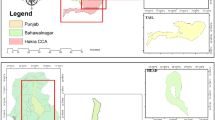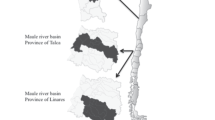Abstract
This paper analyses spatial dependence and determinants of the New Zealand dairy farmers’ adoption of best management practices to protect water quality. A Bayesian spatial durbin probit model is used to survey data collected from farmers in the Waikato region of New Zealand. The results show that farmers located near each other exhibit similar choice behaviour, indicating the importance of farmer interactions in adoption decisions. The results also address that information acquisition is the most important determinant of farmers’ adoption of best management practices. Financial problems are considered a significant barrier to adopting best management practices. Overall, the existence of distance decay effect and spatial dependence in farmers’ adoption decisions highlights the importance of accounting for spatial effects in farmers’ decision-making, which emerges as crucial to the formulation of sustainable agriculture policy.

Similar content being viewed by others
Notes
A Meshblock is defined as the smallest geographic unit for which statistical data is collected by Statistics NZ. Meshblocks vary in size from part of a city block to large areas of rural land.
Water bodies used to calculate the distance from farms to water bodies are refer to observable streams, rivers, and lakes in Google map with the scale of 1:8000 that is seen as an appropriate scale to see small road (http://wiki.openstreetmap.org/wiki/Zoom_levels).
References
Bandiera O, Rasul I (2006) Social networks and technology adoption in northern mozambique. Econ J 116(514):869–902
Bewsell D, Monaghan RM, Kaine G (2007) Adoption of stream fencing among dairy farmers in four new zealand catchments. Environ Manage 40(2):201–209
Case A (1992) Neighborhood influence and technological change. Reg Sci Urban Econ 22(3):491–508
Fairweather JR, Hunt LM, Rosin CJ, Campbell HR (2009) Are conventional farmers conventional? analysis of the environmental orientations of conventional New Zealand farmers*. Rural Sociol 74(3):430–454
Haile DT, Slangen L (2009) Estimating the willingness to pay for the benefit of AES using the contingent valuation method. J Nat Res Policy Res 1(2):139–152
Hassan R, Nhemachena C (2008) Determinants of African farmers’ strategies for adapting to climate change: multinomial choice analysis. Afr J Agr Resour Econ 2(1):83–104
Jørgensen SL, Olsen SB, Ladenburg J, Martinsen L, Svenningsen SR, Hasler B (2013) Spatially induced disparities in users’ and non-users’ WTP for water quality improvements—Testing the effect of multiple substitutes and distance decay. Ecol Econ 92:58–66
Knowler D, Bradshaw B (2007) Farmers’ adoption of conservation agriculture: a review and synthesis of recent research. Food Policy 32(1):25–48
Kurkalova LA, Wade TR (2013) Aggregated choice data and logit models: application to environmental benign practices of conservation tillage by farmers in the state of iowa. Appl Econometr Int Devel 13(2):119–128
Läpple D, Kelley H (2015) Spatial dependence in the adoption of organic drystock farming in Ireland. Eur Rev Agric Econ 42(2):315–337
Lewis DJ, Barham BL, Robinson B (2011) ‘Are there spatial spillovers in the adoption of clean technology? The case of organic dairy farming. Land Econ 87(2):250–267
Manski CF (1993) Identification of endogenous social effects: the reflection problem. Rev Econ Stud 60(3):531–542
van Meijl H, van Tongeren F (1998) Trade, technology spillovers, and food production in China. Weltwirtsch Arch 134(3):423–449
Moon K, Cocklin C (2011) Participation in biodiversity conservation: motivations and barriers of Australian landholders. J Rural Stud 27(3):331–342
Pace KR, LeSage JP (2009) Spatial econometrics. In: Alan E. et al. (Eds.) Handbook of Spatial Statistics, CRC Press, NW: pp 245–260
Parminter TG, Tarbotton IS, Kokich C (1998) A study of farmer attitudes towards riparian management practices. In proceedings of the New Zealand grassland association, 60: 255–258
Rahelizatovo NC, Gillespie JM (2004) Factors influencing the implementation of best management practices in the dairy industry. J Soil Water Conserv 59(4):166–175
Rhodes HM, Leland JLS, Niven BE (2002) Farmers, streams, information, and money: does informing farmers about riparian management have any effect? Environ Manage 30(5):0665–0677
Seo SN, Mendelsohn R (2008) An analysis of crop choice: adapting to climate change in South american farms. Ecol Econ 67(1):109–116
Sutherland RJ, Walsh RG (1985) Effect of distance on the preservation value of water quality. Land Econ 61(3):281–291
Vanslembrouck I, Van Huylenbroeck G, Verbeke W (2002) Determinants of the willingness of belgian farmers to participate in agri-environmental measures. J Agr Econ 53(3):489–511
Waikato Regional Council (2014) Upper Waikato zone plan. Waikato regional council policy series. http://www.waikatoregion.govt.nz/zoneplans/. Accessed 3 Jun 2016
Whittaker G, Färe R, Srinivasan R, Scott DW (2003) Spatial evaluation of alternative nonpoint nutrient regulatory instruments. Water Resour Res 39(4):1079
Wollni M, Andersson C (2014) Spatial patterns of organic agriculture adoption: evidence from Honduras. Ecol Econ 97:120–128
Acknowledgements
We wish to thank DairyNZ for providing the survey data for this study. We would like to thank for the two anonymous reviwers for their valuable comments.
Author information
Authors and Affiliations
Corresponding author
Ethics declarations
Conflict of Interest
The authors declare that they have no conflict of interests.
Additional information
Wei Yang now works at AgResearch Ltd Lincoln Research Centre as a farm economist.
Rights and permissions
About this article
Cite this article
Yang, W., Sharp, B. Spatial Dependence and Determinants of Dairy Farmers’ Adoption of Best Management Practices for Water Protection in New Zealand. Environmental Management 59, 594–603 (2017). https://doi.org/10.1007/s00267-017-0823-6
Received:
Accepted:
Published:
Issue Date:
DOI: https://doi.org/10.1007/s00267-017-0823-6




